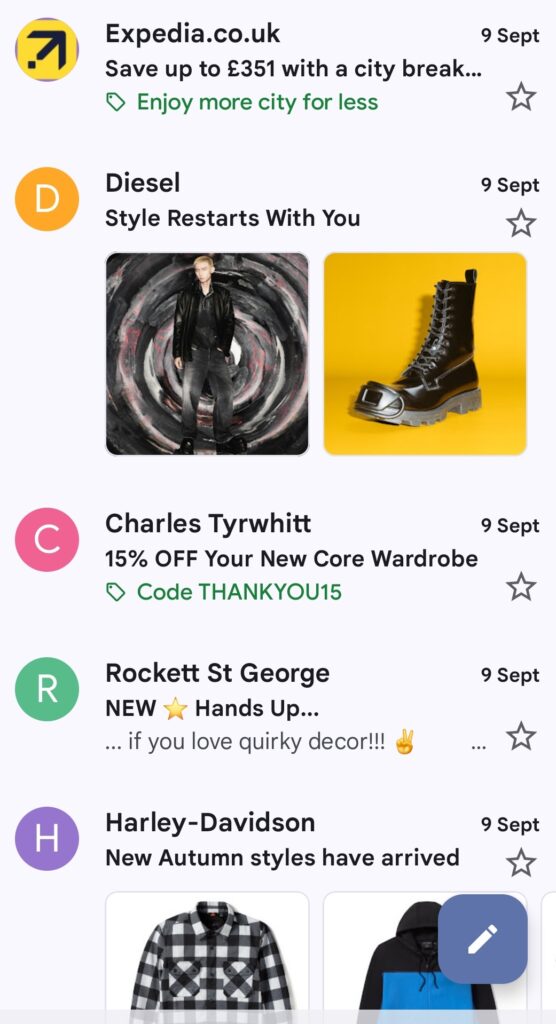Email Marketing
While We’re on the Subject: 10 Ways to Fix Your Subject Lines Before Black Friday
minute read

As Black Friday 2025 comes into focus, email subject lines are more important than ever. In our Litmus State of Email 2025 report, we asked consumers the main reasons why they delete marketing emails without opening them. Almost 30 percent answered, “irrelevant content based on the subject line.” Ouch—talk about falling at the first hurdle!
But, as with many email marketing challenges, this stat also presents an opportunity. Making subject lines more relevant and compelling leads to more email opens, more engagement, and more revenue.
Easier said than done, you say?
Here are ten ideas harnessing the latest email developments to deliver high-performing subject lines.
Start by getting the basics right (including accessibility)
Especially during busy periods like Black Friday, your subject lines have one job: get your emails opened! Remember KISS (“Keep it Simple, Stupid!”). Don’t try to be too clever— your subscribers don’t have time to decode cryptic messages.
A few other tried-and-true subject line tips:
- Keep subject line length below 35 characters so they don’t truncate.
- Front-end load your offers so they get seen.
- Put emojis on the left for maximum impact.
- Use simple language and avoid big words, which helps with readability and is also accessibility-friendly.
Use pre-header real estate
Email pre-headers are like second subject lines. When used smartly, they can seriously increase subscriber engagement. To make yours more impactful, avoid default text like “Having trouble viewing this email? Click here.” This won’t get your emails opened!
Senders should also avoid pre-headers that simply restate the subject line or your brand name. Instead, think carefully about how your pre-headers can complement your subject lines, either by effectively extending them or by making an enticing secondary point.
Below are a few examples of great pre-headers—and some that aren’t so great.

First, the good: Stringjoy uses an enticing subject line that asks a question and uses the pre-header to answer it—all without truncation.
On the other end of the spectrum, Bandsintown lets us know we have a new message…twice! Three times, if you count the email in the inbox itself! They also leave the context to be desired, with some truncation in the subject line and repetition in the pre-header.
Unintended consequences of Gmail annotations
Gmail annotations make marketing emails stand out by displaying key information directly in the Promotions tab, as shown in the examples below. Senders achieve this by deploying a simple schema as part of their email code.

This is how senders get the green code snippets to display, and there is a second schema that can be deployed for the images. Note how these elements replace your carefully curated pre-headers.

However, slow adoption has led to Gmail auto-annotating marketing emails irrespective of whether senders have applied the code or not, sometimes yielding unexpected results. We’ve even seen examples where already-expired discount codes are displayed—not good for spam complaints!
We recommend implementing annotations yourself, so you have full control over the presentation for your Gmail subscribers.
Take the sting out of time-sensitive offers
A big challenge for email marketers is managing time-sensitive promotions (e.g., “Final hours: Summer Sale ends tomorrow!”). When customers see offers after they’ve expired (a common occurrence, especially after the Black Friday/Cyber Monday weekend), the value to the subscriber is zero, and the risk of spam complaints increases significantly.
The Gmail annotations expiration date parameter helps solve this issue by allowing senders to display time-sensitive content as an annotated snippet. Once the expiration date has passed, the snippet will no longer display, reducing frustration and negativity when subscribers realize they’ve missed out!
Use subscriber interests to drive personalization
Using first names in subject lines is a tried-and-trusted personalization tactic, and it’s still effective because people’s eyes naturally focus on their own names. However, it’s also massively overused, leading to diminishing returns. Instead, try personalizing based on attributes like location (“Other people in Silverstone are buying this product”), interests (“Essential for long-distance bike riders”), and life stage (“New homeowners like you”). These examples draw on “nudge theory,” a clever social norms principle whereby people behave in a particular way if they believe others like them are doing the same. This great Marks & Spencer example shows how subscribers can be persuaded to share the personal data that drives this tactic.

Don’t forget your automated emails
Triggered emails typically generate over 10 times the average revenue of standard marketing emails—so make sure the subject lines on your triggered messages are firing on all cylinders.
- Ensure your welcome email’s subject line includes a “Thank you” for subscribing and uses any customer attributes or browsing activity you already have to personalize that message.
- In abandoned cart email, urgency and timing can be more persuasive than discounting. Try something like “Looks like you left something behind—do you need a hand?”
- In re-engagement emails, strong subject lines leverage names, past behavior, and curiosity hooks to reignite interest. Draw on an emotional connection with something like, “Remember When [Personal Experience]?” to draw the person back in.
Use AI-generated subject lines with caution
Be careful when using AI to generate subject lines—treat it as a starting point, not the finish line. AI often leans toward urgent, clickbait-style language and may suggest copy that feels off-brand., Many of your customers want to hear from you in your brand voice—something AI doesn’t yet fully understand.
Try weaving in language your AI isn’t likely to suggest (e.g., names of products, words from your jingle, etc.). Human-generated subject lines, especially from experienced writers who know your brand best, still regularly outperform AI-generated ones. Don’t assume the machine always knows best!
Don’t base subject line testing success purely on opens
When split testing to identify the most effective subject line, email opens often determine the winner because statistical significance is achieved more quickly. However, optimizing subject lines solely to maximize opens can backfire—clicks and conversions may decline if the subject line attracts the wrong subscribers. Worse, it can erode long-term engagement if subscribers feel “tricked” into opening emails with less relevant content.
Ideally, subject line optimization should drive action as far down the funnel as possible, all the way to conversions. If it takes too long to generate enough sales for statistical significance, email clicks provide an acceptable middle ground!
Don’t underestimate the billboard effect
The billboard effect is the brand exposure impact your emails have, even if they don’t generate opens or clicks. Like driving past a billboard, seeing memorable subject lines in the inbox keeps your brand top of mind and influences behavior later, when customers aren’t in their inboxes. Instead, they may Google your brand, visit your website directly, read your product reviews, or walk into your shop! Measure this impact by monitoring for increases in search volume and site traffic, as well as lifts in non-direct revenue (e.g., your Amazon sales).
Looking to take the billboard effect to the next level? Implement BIMI and Apple Branded Mail to showcase your logo in the inbox for all to see! In the example below, you can see how well Qantas and WebMD stand out in comparison to the other emails without their logos featured.

Don’t be misleading
Subject lines play a critical role in generating subscriber trust. But savage competition for inbox eye share means marketers must walk a fine line between being truthful and being too tempting. Overstepping the mark now has real consequences. The Washington State Court ruled that the use of false or misleading information in email subject lines violates the state’s Commercial Electronic Mail Act (CEMA). Mailbox provider guidance also strongly advises against these tactics.
The message is clear: using misleading subject lines won’t just hurt deliverability and engagement—there are now legal consequences too. With penalties reaching up to $53K per email under CAN-SPAM, even small slip-ups will quickly have a major financial impact.
Lots to think about! If you want to dig deeper into this topic to prepare for Black Friday, check out our recent State of Email webinar where we talked about the best tactics to beat your Black Friday competition—including subject lines!